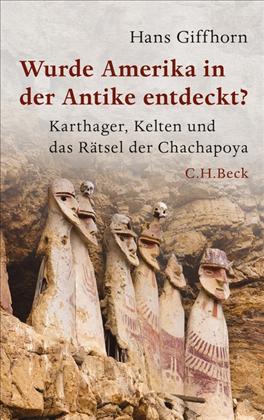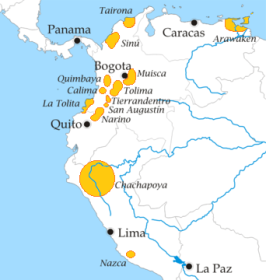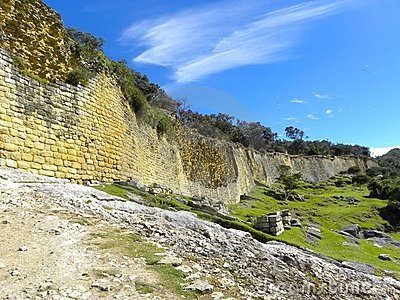mardi, 04 novembre 2014
Chachapoya of Peru Are Probably Carthaginians and Celts Who Fled from Rome in 146 BCE
PBS: Chachapoya of Peru Are Probably Carthaginians and Celts Who Fled from Rome in 146 BCE
Ex: http://www.jasoncolavito.com
See also: ARTE's Broadcasting: http://www.arte.tv/guide/de/048610-000/karthagos-vergessene-krieger
 Holy crap! PBS has become America Unearthed. In an episode of the PBS series Secrets of the Dead running on local PBS stations this week and available online for streaming, the venerable public broadcasting channel asserts that blonde-haired, blue-eyed Celts and also some incidental Carthaginians discovered the Americas in Antiquity. (The blue eyes don’t make the show but show up on the show’s web page.) “Carthage’s Lost Warriors” was produced by ZDF, a German television production company associated with the long-running series Terra-X, which traffics in all manner of fringe theories, and the large number of dubbed German interviews testifies to the recycling of a German program. Archaeologist K. Krist Hurst called the show “baloney.”
Holy crap! PBS has become America Unearthed. In an episode of the PBS series Secrets of the Dead running on local PBS stations this week and available online for streaming, the venerable public broadcasting channel asserts that blonde-haired, blue-eyed Celts and also some incidental Carthaginians discovered the Americas in Antiquity. (The blue eyes don’t make the show but show up on the show’s web page.) “Carthage’s Lost Warriors” was produced by ZDF, a German television production company associated with the long-running series Terra-X, which traffics in all manner of fringe theories, and the large number of dubbed German interviews testifies to the recycling of a German program. Archaeologist K. Krist Hurst called the show “baloney.” The show opens with a “Celtic-style bronze axed” found “deep in the Amazon” and the narrator, Jay O. Sanders, asks if—heaven help us!—the Chachapoya are truly the blond, Caucasian descendants of prehistoric superhero warriors (martial prowess specified explicitly) who crossed the Atlantic at some unspecified date to penetrate the continent with their manly thrusts until they fertilized Peru with the glory of Old World culture.
The program is based on the work of the show’s chief expert, Hans Giffhorn, a professor emeritus of cultural studies at the Universities of Göttingen and Hildesheim and documentary filmmaker. Griffhorn’s dissertation on aesthetics outlined his belief that science is dogmatic and rigid and excludes evidence and theories that fail to conform to paradigms, and that a lack of cross-disciplinary interaction has led to erroneous findings and conclusions.
Griffhorn wrote a German book, still untranslated, on his belief that the Chachapoya are white Europeans in 2013.He believes that the Carthaginians did not “simply vanish” after the Carthaginians were defeated by the Romans in 146 BCE, and he refuses to believe Roman accounts that the city’s population was enslaved or killed under Scipio Aemilianus. He wants to know where they went. To find the Carthaginians—and here he is looking for just one boatload—he starts at the Balearic Islands, where Carthage found its fiercest soldiers. Giffhorn feels that the Carthaginians were not enslaved in their entirety, so for him it is only logical that they fled to Kuelap, the Chachapoya fortress in Peru. He believes that in the western Mediterranean the Carthaginian exiles teamed up with Celtic people from Iberia to escape the Romans, who were also taking over the Carthaginian territories of what is today Spain.
Celtic prowess combined with Carthaginian sailing skills to cross the Atlantic.
 Griffhorn believes the Diodorus Siculus proves that the Carthaginians reached the Americas. Diodorus (Library of History 5.19-20) first describes an island, not a continent, “over against Libya”—meaning off the African coast—and states that it contains stately towns and fruitful plains when the Phoenicians discovered it:
Griffhorn believes the Diodorus Siculus proves that the Carthaginians reached the Americas. Diodorus (Library of History 5.19-20) first describes an island, not a continent, “over against Libya”—meaning off the African coast—and states that it contains stately towns and fruitful plains when the Phoenicians discovered it:
The program is based on the work of the show’s chief expert, Hans Giffhorn, a professor emeritus of cultural studies at the Universities of Göttingen and Hildesheim and documentary filmmaker. Griffhorn’s dissertation on aesthetics outlined his belief that science is dogmatic and rigid and excludes evidence and theories that fail to conform to paradigms, and that a lack of cross-disciplinary interaction has led to erroneous findings and conclusions.
Griffhorn wrote a German book, still untranslated, on his belief that the Chachapoya are white Europeans in 2013.He believes that the Carthaginians did not “simply vanish” after the Carthaginians were defeated by the Romans in 146 BCE, and he refuses to believe Roman accounts that the city’s population was enslaved or killed under Scipio Aemilianus. He wants to know where they went. To find the Carthaginians—and here he is looking for just one boatload—he starts at the Balearic Islands, where Carthage found its fiercest soldiers. Giffhorn feels that the Carthaginians were not enslaved in their entirety, so for him it is only logical that they fled to Kuelap, the Chachapoya fortress in Peru. He believes that in the western Mediterranean the Carthaginian exiles teamed up with Celtic people from Iberia to escape the Romans, who were also taking over the Carthaginian territories of what is today Spain.
Celtic prowess combined with Carthaginian sailing skills to cross the Atlantic.
 Griffhorn believes the Diodorus Siculus proves that the Carthaginians reached the Americas. Diodorus (Library of History 5.19-20) first describes an island, not a continent, “over against Libya”—meaning off the African coast—and states that it contains stately towns and fruitful plains when the Phoenicians discovered it:
Griffhorn believes the Diodorus Siculus proves that the Carthaginians reached the Americas. Diodorus (Library of History 5.19-20) first describes an island, not a continent, “over against Libya”—meaning off the African coast—and states that it contains stately towns and fruitful plains when the Phoenicians discovered it:The Phoenicians therefore, upon the account before related, having found out the coasts beyond the pillars, and sailing along by the shore of Africa, were on a sudden driven by a furious storm afar off into the main ocean; and after they had lain under this violent tempest for many days, they at length arrived at this island; and so, coming to the knowledge of the nature and pleasantness of this isle, they caused it to be known to everyone; and therefore the Tyrrhenians, when they were masters at sea, designed to send a colony thither; but the Carthaginians opposed them, both fearing lest most of their own citizens should be allured through the goodness of the island to settle there, and likewise intending to keep it as a place of refuge for themselves, in case of any sudden and unexpected blasts of fortune, which might tend to the utter ruin of their government: for, being then potent at sea, they doubted not but they could easily transport themselves and their families into that island unknown to the conquerors. (trans. G. Booth)
 He, of course, leaves out the information Diodorus—and, crucially, pseudo-Aristotle three centuries earlier, unacknowledged here—gave about the location of this mysterious island, which regular readers will of course remember quite well from when these same texts were used by Harry Hubbard to claim ancient knowledge of North America, and also from America Unearthed, when Mark McMenamin used the same text from Diodorus to claim that the Phoenicians, not the Carthaginians, discovered America.
He, of course, leaves out the information Diodorus—and, crucially, pseudo-Aristotle three centuries earlier, unacknowledged here—gave about the location of this mysterious island, which regular readers will of course remember quite well from when these same texts were used by Harry Hubbard to claim ancient knowledge of North America, and also from America Unearthed, when Mark McMenamin used the same text from Diodorus to claim that the Phoenicians, not the Carthaginians, discovered America. Pseudo-Aristotle (De mirabilis auscultationibus 84) writes that:
In the sea outside the Pillars of Hercules they say that an island was discovered by the Carthaginians, desolate, having wood of every kind, and navigable rivers, and admirable for its fruits besides, but distant several days’ voyage from them. But, when the Carthaginians often came to this island because of its fertility, and some even dwelt there, the magistrates of the Carthaginians gave notice that they would punish with death those who should sail to it, and destroyed all the inhabitants, lest they should spread a report about it, or a large number might gather together to the island in their time, get possession of the authority, and destroy the prosperity of the Carthaginians. (trans. Launcelot D. Dowdall)
This land was in frequent contact with Carthage before 300 BCE—not a one-time chance encounter in 146 BCE—and was only a few days’ sail from the Pillars. Brazil is about ninety days’ sail from the Pillars, according to the show’s own estimate. It’s a bit of a difference between three months and a few days.
Griffhorn suggests from such texts that the Carthaginians had had secret communication with Brazil but kept it secret. This seems rather odd considering that the Carthaginians put up in the public square a commemoration of the voyage of Hanno to central Africa, where he saw chimpanzees. Surely they would have kept that secret, too, had that been their typical practice, as Griffhorn suggests.
At this point, the Carthaginians virtually vanish from the show because they were needed solely to give the Celts something they lack—ships—for Griffhorn’s real thesis, that the Celts are the ancestors of the Chachapoya and once reigned over South America.
Griffhorn suggests from such texts that the Carthaginians had had secret communication with Brazil but kept it secret. This seems rather odd considering that the Carthaginians put up in the public square a commemoration of the voyage of Hanno to central Africa, where he saw chimpanzees. Surely they would have kept that secret, too, had that been their typical practice, as Griffhorn suggests.
At this point, the Carthaginians virtually vanish from the show because they were needed solely to give the Celts something they lack—ships—for Griffhorn’s real thesis, that the Celts are the ancestors of the Chachapoya and once reigned over South America.

The program tries to make the case that a boat could have crossed to Brazil using the ocean currents. Griffhorn places the discovery of Brazil by the Carthaginians and Celts at “1500 years before Columbus,” which would be about 10 BCE, long after the fall of Carthage. This makes no sense since Diodorus wrote between two and five decades earlier and pseudo-Aristotle three centuries before that—and both claimed the story reported much older events.
Griffhorn believes that the Carthaginian boat pilots traded with local cannibals (with what?) to survive, and Griffhorn believes that four symbols on the ancient petroglyphs on the rock of Ingá in Brazil aren’t just coincidentally close to geometrical shapes used in Celtiberian alphabets but are actual Celtic letters. Apparently the Carthaginian merchants were the merchant class serving the Celtic warrior elite.
Based on no evidence whatsoever, Griffhorn suggests that the Carthaginians and Celts on this voyage of discovery sailed up the Amazon. “No account exists, and we can only imagine” what they did, the narrator says, substituting early Spanish and Portuguese accounts to give an idea of what the Carthaginians “would have” seen and done. So, to recap: Everyone admits that no evidence exists, but they will nevertheless reconstruct an entire adventure based on analogies.
The narrator suggests that brightly-colored vases with geometric patterns made by the Marajoara culture of Brazil are “reminiscent” of Greek vases from the Classical period, decorated with Celtic spirals. This is a subjective judgment, and to my eyes the pots look nothing like the form of actual Greek vases, nor do the decorations bear more than a superficial resemblance to Old World patterns—no more so than any other Native geometric art. Geometric shapes tend to be the same everywhere. The trouble is that the Marajoara culture flourished after 800 CE, far too late to have anything to do with Mediterranean Greek vases from 1,000 years earlier.
We return to the metal axe from the opening that the show calls Celtic. It has no provenance, and was purchased from a merchant who said he found it in the jungle. The metal part of the axe is copper-zinc bronze, meaning that it was from the Old World, but the handle was made of Paraguayan wood. According to tests that the show says were run on the axe, the wood is 1500 years old. The most parsimonious explanation is that a Spanish, Portuguese, or African object was added to a sacred and ancient handle during the Contact period, but instead the show wants us to believe that Celts from 146 BCE dropped it en route to Peru where it was reused in 500 CE.
This brings us to the Chachapoya, and the show demands to know how mere Native people could possibly have learned how to build buildings, particularly round ones, without European help. Prof. Warren Church explains that the Chachapoya were quite able to build their own buildings, of which none date earlier than 500 CE. Griffhorn, however, sees the round buildings as unique in America and therefore of obviously Carthaginian extraction—700 years or more after the fact! He points to a carving of a face on a temple wall and says this is reminiscent of Celtic beheadings, as though no one else on earth ever drew faces or beheaded enemies. He also cites trepanation among the Celts and Chachapoya as another “connection.” Michael Schultz, a paleopathologist, makes an astonishing claim: that “Hippocratic accounts” from 500 BCE describe Chachapoyan trepanation! This is entirely untrue, and I have no idea where he got the idea that the Chachapoya were discussed in Greek literature.

Griffhorn believes that Spanish fortresses that are round must be connected to the Chachapoya’s round houses, even though this is about all they share in common. The show picks out painted images of shamans with antlers in both the Amazon and among the Celts and decides this must be a connection—even though, unacknowledged here, art from Mohenjo-Daro shows the same thing, as, in fact, does shamanic art everywhere, going back to the Stone Age.
This is really going nowhere fast.
Schultz returns again to assert that pre-Contact Chachapoya mummies suffered from tuberculosis, a disease previously thought only to have come with the Spanish. This “new” fact, however, has been known since 2002, and the presence of tuberculosis in the pre-Columbian Americas has been known since 1994—it’s been found beyond just the Chachapoya—but Griffhorn takes this as a revelation that the Carthaginians brought “Classical” tuberculosis (whatever that means—he seems to think the disease was different in Antiquity) with them in 146 BCE, where it lay dormant for a thousand years. Archaeologists suggest that the disease arose from llamas, who are known to carry the bovine form of tuberculosis—or even from the Polynesians who reached South America before Columbus.
Next, various Chachapoyan traits are compared to Spanish, Majorcan, and other cultures from various time periods, as though the Chachapoyans simply adopted one trait from each of the ark of cross-cultural European outcasts from multiple time periods who sailed up the Amazon to meet them.

The show points to the fair-skinned, blonde-haired Chachapoyan descendants as evidence that that some Chachapoyans are “distinctive” from the “dark haired” and “brown-skinned” Natives, and we hear what Cieza de Leon had to say about this, though the paraphrase offered by Warren Church sounds to me like he’s running together bits and pieces from both Cieza de Leon and from Pedro Pizarro, who famously wrote:
The Indian women of the Guancas and Chachapoyas and Cañares were the common women, most of them being beautiful. The rest of the womanhood of this kingdom were thick, neither beautiful nor ugly, but of medium good-looks. The people of this kingdom of Peru were white, swarthy in colour, and among them the Lords and Ladies were whiter than Spaniards. I saw in this land an Indian woman and a child who would not stand out among white blonds. These people [of the upper class] say that they were the children of the idols. (Relation of the Discoveries etc., trans. Philip Ainsworth Means, p. 430)
By contrast, Cieza de Leon (Chronicle of Peru 1.78) was rather less expansive on the particulars:
These Indians of Chachapoyas are the most fair and good-looking of any that I have seen in the Indies, and their women are so beautiful that many of them were worthy to be wives of the Yncas, or inmates of the temples of the sun. To this day the Indian women of this race are exceedingly beautiful, for they are fair and well formed. They go dressed in woollen cloths, like their husbands, and on their heads they wear a certain fringe, the sign by which they may be known in all parts. After they were subjugated by the Yncas, they received the laws and customs according to which they lived, from them. They adored the sun and other gods, like the rest of the Indians, and resembled them in other customs, such as the burial of their dead and conversing with the devil. (trans. Clements Markham)
Rather than put this down to indigenous genetic diversity (which the show briefly acknowledges as possible), the show suggests that this is due to Old World contact. The Carthaginians not being known to be blondes, I guess this is why Griffhorn proposes Celts, whose presumed red hair he wants to equate with reports of fair hair. German geneticist Manfred Kayser tests some Chachapoya hair and finds that the living individuals have some European ancestry tracing back to the Celtic areas of northern Spain, but at this point—500 years after Contact—it’s not possible to determine when the genes mixed. The homeland of the Celtic people Griffhorn fingers is the same as that of the Spanish who traveled to Peru in the 1500s; the Celts didn’t simply vanish after the Roman conquest of Spain (218 BCE to 19 BCE) but contributed to the gene pool of medieval and modern Spain, though the language and culture died out around the fifth century CE. No ancient Chachapoyan mummies were tested, which is a major omission.
The show concludes that there is no “smoking gun,” only suggestive indications that the Chachapoya are not really Native Americans on the same stripe as the brown ones but owe their culture, their art, their religion, and their very genes to a boatload of Carthaginians and Celts who sailed up the Amazon in 146 BCE and, by dint of their superior European prowess, took over to such an extent that their potent DNA still rules the region 1,868 years later, largely undiluted by the intervening centuries.
I guess this means that they’re all inbred, but the show doesn’t go there.
This was really terrible, and the only significant difference between this show and America Unearthed in terms of quality of evidence and the desire to find hidden white people in the Americas is that this show searched South America rather than North America, and its hero never claimed that there was a conspiracy trying to suppress his work.
The show concludes that there is no “smoking gun,” only suggestive indications that the Chachapoya are not really Native Americans on the same stripe as the brown ones but owe their culture, their art, their religion, and their very genes to a boatload of Carthaginians and Celts who sailed up the Amazon in 146 BCE and, by dint of their superior European prowess, took over to such an extent that their potent DNA still rules the region 1,868 years later, largely undiluted by the intervening centuries.
I guess this means that they’re all inbred, but the show doesn’t go there.
This was really terrible, and the only significant difference between this show and America Unearthed in terms of quality of evidence and the desire to find hidden white people in the Americas is that this show searched South America rather than North America, and its hero never claimed that there was a conspiracy trying to suppress his work.
00:05 Publié dans archéologie | Lien permanent | Commentaires (1) | Tags : archéologie, pérou, chachapoyas, andes, amérique latine, amérique du sud, américanologie, civilisations pré-colombiennes, archéologie andine |  |
|  del.icio.us |
del.icio.us |  |
|  Digg |
Digg | ![]() Facebook
Facebook



Commentaires
Giffhorn suggère énormément de choses mais ne prouve rien et fonde une théorie sur l'éventuelle présence celte dans les bagages des Carthaginois sur l'écriture. J'entretiens personnellement une correspondance régulière avec mes enfants en alphabet phénicien lorsqu'ils sont en déplacement, mon clan d'origine étant phénicien (Carthage), et j'affirme pouvoir déchiffrer aisément le celte au même titre que l'hébreu (qui n'est qu'une copie quasi conforme), l'apha (aleph: bœuf) bet (beth: maison) phénicien est la matrice originelle des alphabets qui prédominent dans notre monde actuel. Par conséquent je doute du sérieux de cette théorie. A contrario, de la présence carthaginoise en Amérique flanquée de Guanches emmenés cordialement au passage je ne m'étonne guère. Les Carthaginois n'eurent point utilité de s'acoquiner à des Celtibères puisque les Baléares étaient pour ainsi dire désertes lorsque les Carthaginois en prirent possession à l'époque d'Homère alors que Rome naissait à peine et comme si tous les Celtes avaient été élancés, blonds ayant des yeux bleus. Cela confine à la mythomanie. Prêche-t-il pour sa chapelle?
Écrit par : mbm | samedi, 22 novembre 2014
Les commentaires sont fermés.